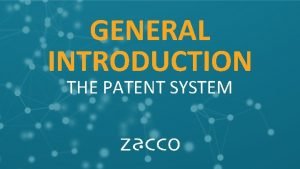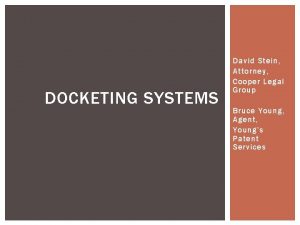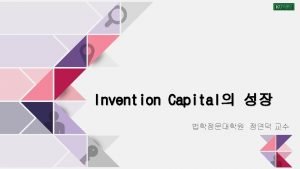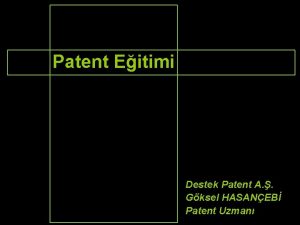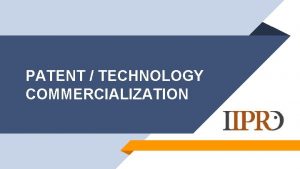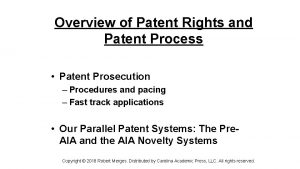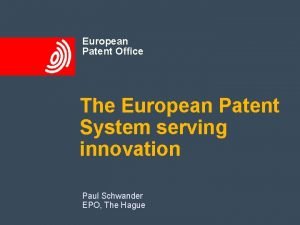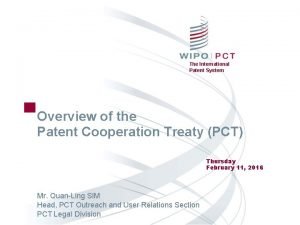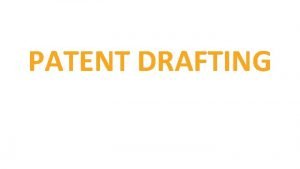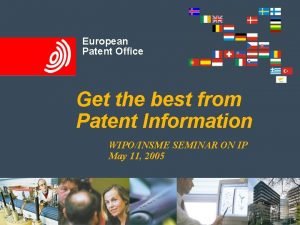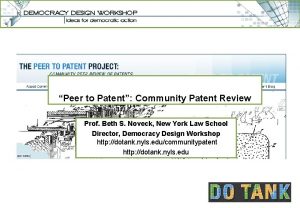GENERAL INTRODUCTION THE PATENT SYSTEM GENERAL INTRODUCTION OF














- Slides: 14

GENERAL INTRODUCTION THE PATENT SYSTEM

GENERAL INTRODUCTION OF THE PATENT SYSTEM: FROM IDEA TO GRANT • • 2 What is an invention Who is an inventor Means of protection Procedural phases up to grant General grant proceure at IPO Where to file Filing strategy © Zacco 2018

WHAT IS AN INVENTION • Creative achievement that enables a concrete and technical solution to a given technical problem • An invention may be in any field of technology, provided it is new, involve an inventive step (non-obvious) and is susceptible of industrial application 3 © Zacco 2018

WHAT IS AN INVENTION Patentable inventions in the area of life science, for example: • Proteins and nucleic acids (DNA/ RNA) incl. their use(s), e. g. , enzymes having useful functions • Chemical compounds incl. their medical or non-medical use(s), e. g. , compounds acting as agonists or antagonis on certain disease related receptors • Genetically modified (micro)organisms incl. methods of productions, e. g. , an genetically modified mosquito which, when released into the wild, mates with female mosquitoes to produce sterile progeny • Genetically modified plants, altered to carry a new characteristic, such as resistance to pests or droughts, or enhanced yield • Diagnostic kits and methods, e. g. , gene-based breast cancer test 4 © Zacco 2018

WHAT IS NOT AN INVENTION • Not regarded as inventions are creative achievments which are either of abstract or non-technical nature, such as: (a) discoveries, scientific theories and mathematical methods (b) aesthetic creations and presentations of information (c) schemes, rules and methods for performing mental acts, playing games or doing business, and programs for computers • Exception to c): in US are business methods are patentable inventions 5 © Zacco 2018

WHO IS AN INVENTOR • No universal criteria for the determination of inventorship, rather inventorship is defined by national legislation in each country under consideration. • In the case inventions are made in the course of employment, inventorship from a European perspective is generally determined by the legislation of the country of business of the employer • In some jurisdictions the question of inventorship may not necessarily be determined on the basis of the national legislation of the country of business of the employer, but on the national legislation in the country for which a (national) patent application has been filed (e. g. , in US) 6 © Zacco 2018

WHO IS AN INVENTOR • Generally speaking: An inventor is a natural person who has made an independent, intellectual contribution directed at the invention • This can be anyone who: (a) Conceived the initial idea(s) which define the research led to the invention (b) Actually devised the experiments or products which form the basis of the application (c) Carried out any experiments or other processes which required that person to show initiative to conceive and/or complete the invention (d) Interpreted the data and recognized the significance of results 7 © Zacco 2018

WHO IS AN INVENTOR • This will not include anyone who: (a) Simply carried out work under instruction (regardless of how much skill and effort this took) (b) Had no part in the research (regardless of whether or not they funded it, were associated with it, owned the facilities which were used in the research , contibuted very general work or assistance) (c) Was a project manager or supervisor but did not contibuted technically to actual invention • Inventorship and authorship are not the same: co-authors may not necessarily be co-inventors 8 © Zacco 2018

MEANS OF PROTECTION • There are generally two intellectual property rights protecting inventions: patents and utility models • Patents: - for any kind of invention - examined right - 20 years of life time (as of the filing date) • Utility model (e. g. , in DE, CN): - for any kind of invention, except methods and non-medical uses - unexamined right - 10 years of life time (as of filing date) 9 © Zacco 2018

PROCEDURAL PHASES UP TO GRANT • Drafting application Pre-drafting Drafting • Invention disclosure • Defining subject matter • Novelty Search 10 © Zacco 2018 Filing • Filing application with selected Intellectual Property Office Prosecution Grant • Formal and substantitve examination of application by IPO

GENERAL GRANT PROCEURE AT IPO 11 Filing Receiving Search Examination Application is filed with the IPO Application is received, processed and examined as to formal requirements Prior art search and drawing up Search Report incl. Written Opinion Substantive examination of application © Zacco 2018 Grant

WHERE TO FILE • Patent applications can be filed with: a) National Patent Offices such as - Slovenian Intellectual Patent Office (SIPO) - German Patent- and Trademark Office (DPMA) - Institute of Intellectual property Luxembourg (IPIL) b) Supranational patent organisations such as - European Patent Office (EPO) - International Bureau (IB) 12 © Zacco 2018

FILING STRATEGY 0 months File first (national) application e. g. in SI, DE, LU, EP 12 months Claim priority of first application File PCT application Search Report © Zacco 2018 22 months Publication of application 30 months National prosecution File second (national) application e. g. in EP, US, JP, CN, KR 13 18 months National prosecution Chap I PCT Chap II PCT Internationl Preliminary Examination Request for International Preliminary Examination Enter national phase in e. g. in EP, US, JP, CN, KR

THANK YOU FOR YOUR ATTENTION Dr. Carsten Prusko / Dr. Hajo Peters cpu@zacco. com / hpe@zacco. com 14 © Zacco 2018
 Introduction of patent
Introduction of patent Appcoll docketing
Appcoll docketing Hình ảnh bộ gõ cơ thể búng tay
Hình ảnh bộ gõ cơ thể búng tay Slidetodoc
Slidetodoc Bổ thể
Bổ thể Tỉ lệ cơ thể trẻ em
Tỉ lệ cơ thể trẻ em Gấu đi như thế nào
Gấu đi như thế nào Tư thế worms-breton
Tư thế worms-breton Alleluia hat len nguoi oi
Alleluia hat len nguoi oi Môn thể thao bắt đầu bằng từ đua
Môn thể thao bắt đầu bằng từ đua Thế nào là hệ số cao nhất
Thế nào là hệ số cao nhất Các châu lục và đại dương trên thế giới
Các châu lục và đại dương trên thế giới Công của trọng lực
Công của trọng lực Trời xanh đây là của chúng ta thể thơ
Trời xanh đây là của chúng ta thể thơ Cách giải mật thư tọa độ
Cách giải mật thư tọa độ
